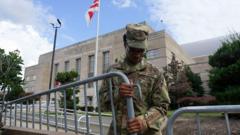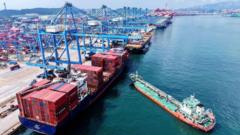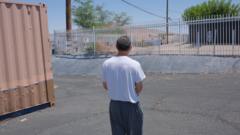Homeland Security Secretary Kristi Noem stated that the US-Mexico border wall will be painted black under the directive of President Trump, a measure intended to make the structure hotter and harder to climb. This initiative coincides with a significant drop in border crossings and a recent allocation of $46 million for border security enhancements, including more waterborne infrastructure along the Rio Grande.
US-Mexico Border Wall to Be Reinforced with Black Paint to Combat Climbing

US-Mexico Border Wall to Be Reinforced with Black Paint to Combat Climbing
In a bid to strengthen the US-Mexico border wall, the Biden administration announces plans to apply black paint to the structure, aiming to deter climbers and enhance durability.
The Biden administration is reinforcing the nearly 2,000-mile-long US-Mexico border wall by painting it black, a move designed to deter potential climbers and enhance the wall's durability. This plan was announced by Homeland Security Secretary Kristi Noem, who attributed the concept to former President Trump.
The administration has earmarked approximately $46 million for border wall construction as part of a broader immigration policy that primarily focuses on domestic apprehensions and deportations. Currently, construction efforts are underway, with about half a mile (0.8 km) of wall being raised each day along the extensive border.
Noem shared her insights during a press briefing at a New Mexico border site, emphasizing that black paint would increase the wall’s temperature, thereby making it more challenging for individuals to scale. She stated, "[The president] understands that in the hot temperatures down here, when something is painted black it gets even warmer, making it even harder for people to climb." Additionally, the choice of paint is expected to help prevent rusting.
The drop in border crossings has been a notable trend over recent months, with the Trump administration attributing this decline to aggressive law enforcement policies. In July, the number of apprehensions plummeted to around 4,600, reflecting a 92% decrease year-on-year, compared to the Biden administration's average of 6,000 daily detentions at times.
Furthermore, Noem mentioned the plans to introduce "waterborne infrastructure" along the Rio Grande, which forms a significant portion of the border. While specific details about these projects were scarce, Texas officials have implemented measures such as floating barriers and reinforced fencing along the river, supported by local law enforcement and the National Guard.
The overall strategy appears to focus on increasing border security and deportations, with approximately 300,000 undocumented immigrants reportedly detained since January. Although the administration claims to prioritize the deportation of individuals with criminal records, advocates have warned that many without serious charges have been swept up in enforcement actions.
As the administration pushes forward with its border security measures, discussions surrounding immigration policies continue to evolve, revealing the complex dynamics at play in the ongoing efforts to manage migration at the US-Mexico border.























